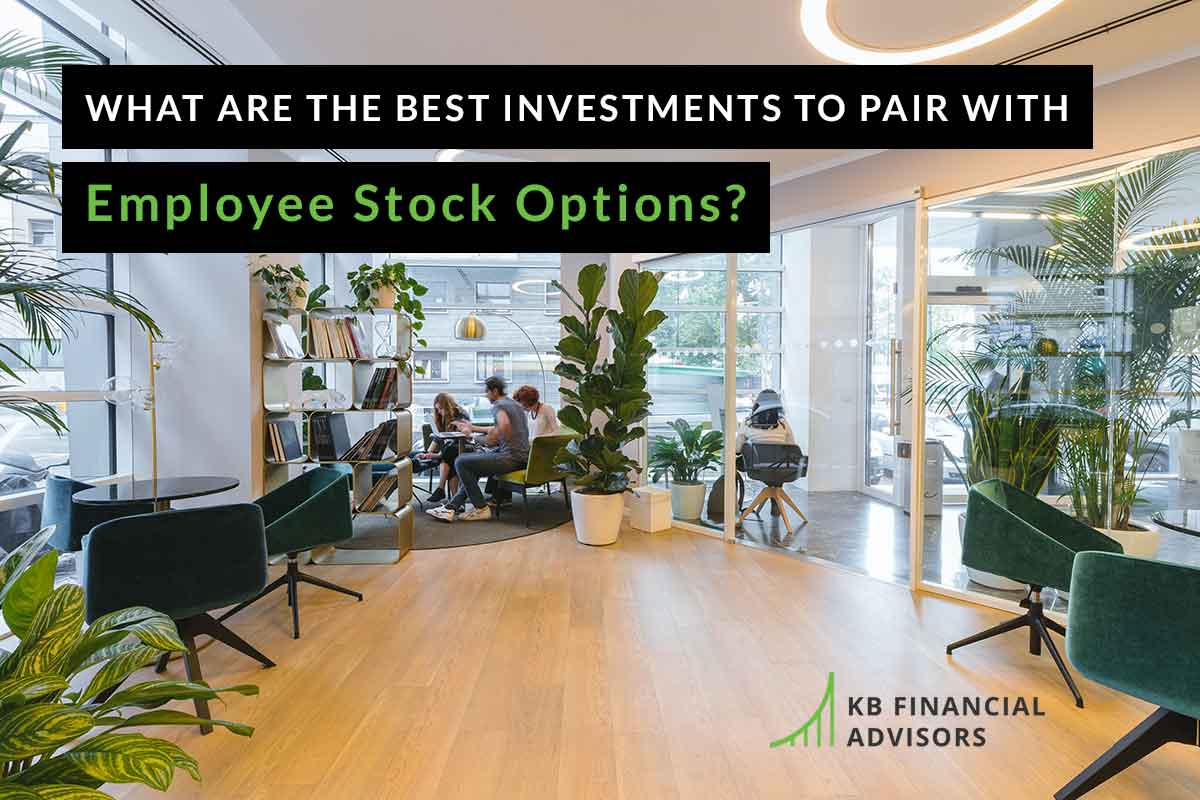Anytime we have a client with stock options and an IPO in the future (which is often), we build their financial plan around five key areas:
- Career
- Stock Options
- Taxes
- Cash Flow
- Investments
You’ll notice that stock options are #2 and investments are #5…
Yet so many of our clients want to jump the gun ASAP from #2 to #5, meaning the instant they get any kind of liquidity or cash, they’re trying to shove it into a new investment.
I appreciate their gusto, so instead of being the boring, financially-driven big brother that berates you about taxes and cash flow… I’m going to talk about what investments can pair well with your stock options so you can start thinking ahead. After all, good planning never hurt anyone.
But First… Taxes and Cash Flow ????
Okay, boring big brother for just a second:
Don’t get in a hurry to invest.
As you can see in our five-part financial plan above, investments are the last piece of the puzzle, and they’re the last piece of the puzzle for a reason.
That said, they are probably the most important piece, since the goal of a good plan is to create financial independence, which means your investments make having a career completely optional.

But, my friend, there are things you need to take care of before you jump to the investment piece in order to make that investment piece successful.
Your IPO = Why Taxes are #3
After an IPO, employee stock options (piece two of the five-piece puzzle) are usually a multi-year plan, especially if you’re dealing with incentive stock options (ISO).
Trust me: you’ll notice it’s like you had a financial life before the IPO, a financial life during the IPO, and a financial life after the IPO is settled and dealt with… and they’re all very different.
To get a clearer picture: the “during the IPO” years are usually three to five years. For example:
- The first year is exercising incentive stock options.
- The second year is paying the AMT.
- The third year is selling your shares.
- The fourth year is paying long-term capital gains tax on the shares you sold.
Especially if your stock value continues to rise and things go well, there will be a solid three to five years that feel like being a rat on an exercise wheel: you’re going around, around, and around, and never getting anywhere… only paying taxes again and again.
Because of this, the last thing you want to do is get the wad of cash you get from selling to immediately start investing… you’ll need it to pay taxes over the next few years! ????
Plus, as a financial advisor, any time I’m working with clients who have an investment horizon of less than five years, the downside risk in the stock market is greater than the upside potential. (Meaning the risk of catastrophic loss, like we’ve seen tech stocks do from September 2021 to now, is higher than the chance of things going well. We’ve seen many of our clients deal with losses higher than 50%, at a time when the market as a whole is down only 15% to 25%… so, yeah.)
Lesson: When you have a lot of things going on that will require cash (like paying AMT or paying long-term capital gains tax), don’t put that cash at risk in another investment… especially the stock market.
Cash Keeps You Covered
Once you slow your roll and get yourself out of a hurry to make new investments ASAP, wrap your head around how important it is to have cash on hand. ????
Cash is king, and you’ll need a lot of it as you navigate your stock option plan.
You’ll need it to pay taxes, which can sometimes be higher than your yearly salary!
So first and foremost, set cash aside for taxes. Even if your stock declines, you will need to pay your taxes based on the price of when you sold, not whatever it happens to be at the moment the tax bill comes due. And you need cash on hand to do that.
Cash = Incredible Insurance
Cash, in and of itself, can buy you the ability to take greater risks with your stock options and shares.
If part of your stock option plan includes holding shares, having additional cash on hand can be a nice way to have some insurance in case the stock price goes down and you have to wait longer than expected to sell after the stock value recovers.
Not to mention, you can use it to fund your goals… like buying a house or paying for a wedding. If the goal you need the cash for is within five years or less, there’s absolutely nothing wrong with keeping that cash as cash, and not exposing it to risk.
Your Investment Portfolio: The Fun Part!
Once you understand the first importance of the 3+ year cycle of stock options and keeping cash needed to pay taxes and fund short-term goals, you can decide what to do with the money that’s left over.
This is the fun part you’ve been waiting for, in other words.
When we start building out an investment portfolio for most clients, we recommend a portfolio that’s allocated 60% to stocks, and 40% to bonds.
Why?
Historically, when you look at a portfolio allocated this way, you’ll get a majority of the stock market’s returns, with a lot less of the volatility.
Over time, the chart of a 60/40 portfolio looks a lot smoother than a “riskier” portfolio.
But once you know that a 60/40 split is a good way to go… how do you go about doing that?
It’s not uncommon for us to work with clients who have $1 million in cash they need to invest, and looking at the less-than-five-years time frame, we’re always thinking about the possibility of catastrophic losses. Our clients are good about holding their investments once they make them (and not pulling out too soon when things go south for a bit), but it’s still a terrible feeling when you invest $1 million in cash, and the stock market goes down, turning that $1 million into $750,000 or less.
For this reason, once you start investing that significant amount of cash, it’s perfectly reasonable to do so via dollar cost averaging and spread the amount of cash you have to invest over 12 months. (If a client had $2 million to invest over a year, we’d invest monthly installments of about $165,000 per month.)
This way, if we’re on the verge of a major stock market correction, we can dollar cost average into that correction rather than investing a large lump sum and watching it decline quickly.
Rebalancing Your Portfolio After Your Investments
The other important thing we do when creating an investment plan that pairs well with your stock option plan is to use event-based rebalancing.
We start with the 60/40 target, but within that portfolio, we could have as many as 10 different asset classes, all with different expected rates of return. Which means, over time, those asset classes with higher rates of return will grow to be a larger portion of your portfolio, and the 60/40 will turn into something closer to 70/30 or 80/20, for example.
This is fine to a point, because as it happens, the portfolio drifts towards a higher expected rate of return. We’ll let it drift in this direction, but as the opportunity arises, we’ll rebalance it.
The first way to rebalance is via rules-based rebalancing.
This is where you have a target for each of your asset classes, and a tolerance band for each asset class. Any time one of those asset classes grows outside of its tolerance band, you sell one asset class to buy another.
We, though, prefer event-based rebalancing. When you get a new flow of cash to invest, it’s considered an “event” that you can use to rebalance your portfolio. This works really well with individuals who have stock options, because the flows of new cash to invest happen frequently.
By doing this, we buy more of what’s either underperformed or been overshadowed by over-performing assets. (AKA, asset classes that can be viewed as “cheap.”)
When you can do event-based rebalancing, you avoid selling over performing assets at the wrong time, which is what might happen if you used rules-based rebalancing.
The other reason we like events-based rebalancing is that it can automate your buying load. Any time we plug new cash into the portfolio, we’re by default purchasing more of the underperforming asset classes at that time, which are “cheap” compared to the higher-performing asset classes that are now “expensive.” These things do change, however, which is the purpose of diversification and having different asset classes… what’s cheap and underperforming today could be your superstar investment tomorrow.
2019, for example, was a great year for the stock market. This meant that our clients were putting a lot of their new investment cash into the bonds side of their portfolios.
Then, in March 2020, the stock market corrected, and the new cash went into the stock side of their portfolios.
2021 was another great stock market year, and new cash went to bonds.
Now, in 2022, instead of one big correction, we’ve had a slow, steady decline since last fall, so a lot of new cash is going into stocks.
As you can see, our clients didn’t have to sell anything that was doing well in order to keep their portfolios balanced… and when other assets started doing well, they were in a great position to gain from them because they’d bought plenty of them while they were “cheap.”
How do you make sure your stocks are balanced?
Okay, knowing that you need a 60/40 split between stocks and bonds is great and all… but how the heck do you know what stocks to buy to make up that 60%?
When we’re working through your stock option plan, it’s implied that you’re over-concentrated in one area, because the majority of your net worth is in your company’s stock. (i.e. ONE stock out of the entire stock market.)
It’s great for an IPO, but it’s not a position you want to continue to maintain, because if that one stock containing most of your net worth crashes, your net worth crashes along with it.
The first step to move from a concentrated stock position to a diversified portfolio is to stop buying more of that single stock.
After that, you need to customize your stock plan so that you’re not buying more of what you’re selling. If your company is a large tech stock that you’re actively selling as a part of your stock option plan… you do not want to turn around and use your cash to buy other large tech stocks.
You also won’t want to invest it into a total US stock market fund, which will buy more of what you were just selling and paying taxes on. It makes no sense.
One of the best ways to avoid doing this is through using separately managed accounts, or SMAs. If you’ve got $2 million or more to invest, you can use an SMA for the US stock market portion of your portfolio… and you’re given the ability to exclude securities, individual stocks, or sectors. (Meaning, for your SMA, you wouldn’t buy your company’s stock or other large tech stocks.)
What are the best investments to go with YOUR stock options?
My hope is that this article has cleared things up for you about which investments would be smart ones to make alongside your stock options plan.
(And you “get it” why I & other financial advisors will push you to think about taxes and cash flow before jumping into a cool new investment strategy. ????)
If you’re interested in getting a solid tax, cash flow, and investment plan set up for your situation, feel free to book a discovery call with us here. It’s a no-obligation call, and we’d love to help you get on the path to financial freedom.



